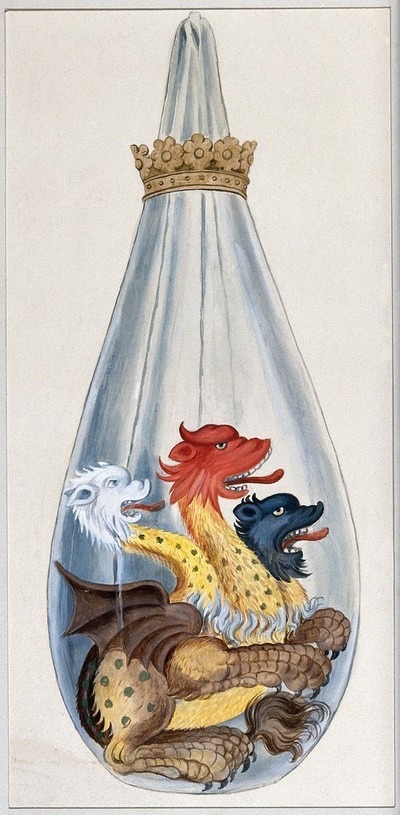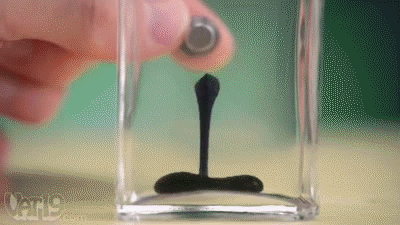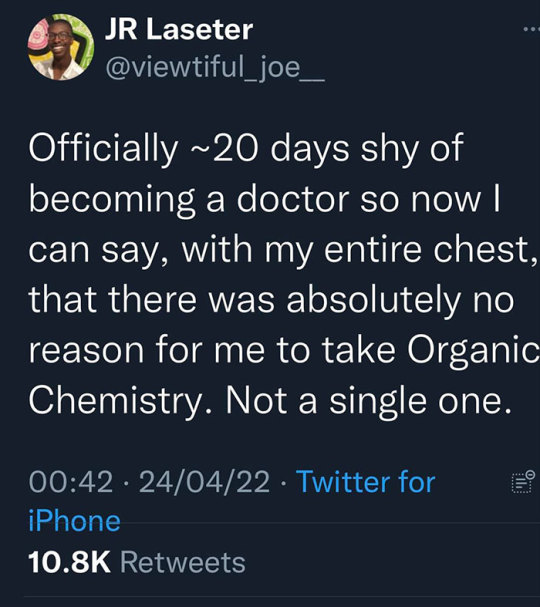#chemistry and medicine
Text
Teenagers who regularly puff away on their vape throughout the day could be exposing their bodies to potentially toxic metals.
A new study led by researchers from the University of Nebraska has found that regular vapers between the ages of 13 and 17, who report using an e-cigarette at least eight times a day, have 30 percent more lead and twice as much uranium in their urine compared to their peers who only occasionally vape.
Among teens who preferred sweet vape flavors, as opposed to menthol or mint ones, biomarkers of uranium were especially high.
The research lacks a control group of teens who did not vape at all, but the pattern evident within a US sample of 200 e-cigarette users who avoided cigarettes is still concerning. For the sake of public health, the researchers argue for further investigation into the potential toxicity of e-cigarettes.
The results of this small study do not prove that vaping causes toxic metal accumulation in the body, but previous analyses have consistently found signs of toxic metals in e-cigarette aerosol samples and in the bodily fluid of vapers. At times, the blood and urine samples of vapers rival even those of cigarette smokers.
Continue Reading.
312 notes
·
View notes
Text
At the centre of Rosalind Franklin’s tombstone in London’s Willesden Jewish Cemetery is the word “scientist”. This is followed by the inscription, “Her research and discoveries on viruses remain of lasting benefit to mankind.”
As one of the twentieth century’s pre-eminent scientists, Franklin’s work has benefited all of humanity. The one-hundredth anniversary of her birth this month is prompting much reflection on her career and research contributions, not least Franklin’s catalytic role in unravelling the structure of DNA.
. . .
But Franklin’s remarkable work on DNA amounts to a fraction of her record and legacy. She was a tireless investigator of nature’s secrets, and worked across biology, chemistry and physics, with a focus on research that mattered to society. She made important advances in the science of coal and carbon, and she became an expert in the study of viruses that cause plant and human diseases. In essence, it is because of Franklin, her collaborators and successors, that today’s researchers are able to use tools such as DNA sequencing and X-ray crystallography to investigate viruses such as SARS-CoV-2.
. . .
Franklin was an inveterate traveller on the global conference circuit and a collaborator with international partners. She won a rare grant (with Klug) from the US National Institutes of Health. She was a global connector in the booming early days of research into virus structures: an expert in pathogenic viruses who had gained an international reputation and cared deeply about putting her research to use.
It is a travesty that Franklin is mostly remembered for not receiving full credit for her contributions to the discovery of DNA’s structure. That part of Franklin’s life story must never be forgotten, but she was so much more than the “wronged heroine”, and it’s time to recognize her for the full breadth and depth of her research career.
#rosalind franklin#nature#article#science#research#dna#covid#biology#chemistry#physics#medicine#health#histroy#women's history#x ray
609 notes
·
View notes
Text

I don't know, I think Maomao and Haibara would be friends (ft. modern AU Maomao).
#maomao#haibara ai#miyano shiho#kusuriya no hitorigoto#kusuriya maomao#the apothecary diaries#knh#detective conan#meitantei conan#dcmk#They both make medicine/drugs and they're both into chemistry you know what I mean?#And you probably shouldn't mess with them#I like them both very much#modern au
136 notes
·
View notes
Text
So I was at this like, class thingy at the rec center that is best described as a mix of chemistry and a practical effects course for people wanting to go into that industry, and they were doing a thing about how people in movies are able to be set on fire without dying, and use the clip of Giles attacking Angel from this
youtube
Buffy behind the scenes/blooper/whatever the fuck it’s called reel as a demonstration, so while the teacher person was trying to like, talk about how it worked, you just heard the sound of a baseball bat thwacking air in the background.
#dream#text#November 4th 2023#class#rec center#chemistry#course#movie#fire#fire tw#giles#angel#buffy#blooper#teacher#baseball#violence tw#covid#fever#cough medicine#medicine#queueueueueueueueueueueueueue#4th#November#2023
178 notes
·
View notes
Text
I don't care what mmHg advocates say, millimeters mercury has and always will be a cursed measurement.
Especially in medicine. Oh, are you gonna hook up the patient's cardiovascular system to a column of mercury to gauge the heckin' mitral valve pressure?
123 notes
·
View notes
Text

A three headed monster in an alchemical flask.
The three heads represent the composition of the philosopher's stone: salt, sulphur, and mercury.
Watercolour painting by E.A. Ibbs. Circa 1900
#history#curiosity#own post#alchemist prime#alchemy#medicine#art history#artwork#watercolourpainting#philosopher’s stone#chemistry#monster
260 notes
·
View notes
Text
Calling all science students and enthusiasts!!
I would absolutely love to have a science-revolving passion project and I’ve narrowed it down to a blog/blog-type-website. I love learning about science but so rarely take the time to actually research the things that interest me. With being a high school student, exams and life this is quite a big task to handle for 1 person and I’d love others to contribute to this!
This is by no means a set plan yet, I’m just sharing a rough idea, so if you could please interact with this post or dm me if you would be interested in something of this kind. Even if you see this 5 months after this was posted (and hopefully a working project or at least WIP) still reach out if you’re interested.
You don’t have to be a great writer for this either nor fascinated about each and every science. My favourite is chemistry, but it would be nice if this project could incorporate the 3 main branches of science: biology, chemistry and physics. It depends on if people would be interested in reading something like this or participating in, and their preferred subjects. You could write about astronomy as a whole, or go into chemistry and analysing electronic configuration, talking about your favourite dinosaur bones in palaeontology, a passive behaviour analysis in psychology, or explaining how exactly scabs work in biology. These would probably be short to mid-length entries and 1/2 times a month.
But this is just my idea and how far I’ve gone with it, feedback is appreciated, there will be more updates to come (not too many until afer my exams in May tho), and I appreciate any reblogs to share this idea with others!
Hopefully a couple people would like to help out in this project and please ask questions if you have any (as a dm or ask) ^^
#studyblr#uni student#university#student#a levels#science#passion project#group project#chemistry#biology#physics#medicine#astronomy#psychology#Sociology#palaeontology#botany#microbiology#toxicology#biotechnology#geology#meteorology#earth science#biochemistry#dark academia#light academia#community project#scienceblr#science blog#the sci journal
87 notes
·
View notes
Text

LIQUID MAGNETS
This is ferrofluid- a liquid substance that responds to the presence of magnets with these really cool reactions!
Ferrofluid is actually made of tons of tiny tiny particles of iron or another magnetic metal suspended in water. Each of the particles are coated in a surfactant to keep them from all bunching together, and that's why it looks like a cohesive liquid.
This compound is paramagnetic. That means that it won't automatically stick to iron or other magnetic materials, but when a magnetic field is applied, each of the tiny iron particle becomes a magnet and moves and reacts to the field. Depending on how you apply the magnetic field, this can create some pretty cool effects!
youtube
Ferrofluid was actually created in the early 1960s by Steve Papell, a NASA engineer that was trying to come up with a type of rocket fuel that can be easily moved around in zero gravity.
Today, ferrofluid is used in products like loudspeakers and hard drives, but they could potentially be used in the biomedical field as a way to help deliver drugs to certain areas of the body. The drugs would be attached to small amounts of ferrofluid, and then selectively released magnetic fields could help guide them to where they need to go.
You can also just... buy a bottle of it to play with like in the gif at the top. They sell it on Amazon (just be cautious and take appropriate precautions handling it if you have an unsealed container).
#stem#science#chemistry#biochemistry#medicine#science side of tumblr#stemblr#magnets#science experiments#science education#magnetism
235 notes
·
View notes
Text


In 1952, these two men, James Watson and Francis Crick, claimed to have discovered the double helical structure of DNA. In 1962, they were awarded the Nobel Prize in Physiology/Medicine.
Unbeknownst to most at the time, they stole their work from female chemist, Rosalind Franklin. These two men are disgusting misogynists. Science teachers of Tumblr, I beg you to stop posting photos of the men who actively suppressed a woman who made one of the greatest scientific discoveries of all time.
#james watson#francis crock#rosalind franklin#nobel prize#dna#science#scienceblr#medicine#chemistry#chem#math#mathematics#1960s
600 notes
·
View notes
Text

Tiny Jote doodles, you can tell me 6 yo Jote ‘nursed’ a comatose Joshua all you want SE that what SHE thought she was doing because she was a kid
#Joshua: you nursed me when u were six? How?#Jote: i brushed your hair#(She used the brush roughly with a thud)#Joshua gets weird faint ptsd from combs but he doesn’t remember why#Thats why his hair is a big bush#True story#tt#Jote trying to insert chocolate chip into comatose joshua mouth:#The undying nurse: NO-#she is the undying spoiled very loved kid and they all collectively raised her and you will take that out of my dead cold hands#They got her all the cute little dresses#She also is studying chemistry and herbal medicine etc joshua is the treating dummy i mean the friend that let her practice#joshua rosfield#jote#ffxvi#final fantasy xvi
71 notes
·
View notes
Text
Scientists in Australia think they have discovered a better way to treat the deadliest and most aggressive form of breast cancer.
Unlike chemotherapy, the new treatment approach kills and slows the growth of only cancerous cells within breast tissue, not normal, healthy ones.
The oral medicine also targets metastatic lesions that have spread elsewhere in the body and show resistance to chemotherapy.
Continue Reading.
192 notes
·
View notes
Text
Exploring the Marvels of Biological Macromolecules: The Molecular Machinery of Life (Part 3)
Proteins and Enzymes: Catalysts of Molecular Reactions
Proteins are the central players in macromolecular interactions. Enzymes, a specialized class of proteins, catalyze biochemical reactions with remarkable specificity. They bind to substrates, facilitate reactions, and release products, ensuring that cellular processes occur with precision.
Protein-Protein Interactions: Orchestrating Cellular Functions
Proteins often interact with other proteins to form dynamic complexes. These interactions are pivotal in processes such as signal transduction, where cascades of protein-protein interactions transmit signals within cells, regulating diverse functions such as growth, metabolism, and immune responses.
Protein-Ligand Interactions: Molecular Recognition
Proteins can also interact with small molecules called ligands. Receptor proteins, for instance, bind to ligands such as hormones, neurotransmitters, or drugs, initiating cellular responses. These interactions rely on specific binding sites and molecular recognition.
Protein-DNA Interactions: Controlling Genetic Information
Transcription factors, a class of proteins, interact with DNA to regulate gene expression. They bind to specific DNA sequences, promoting or inhibiting transcription, thereby controlling RNA and protein synthesis.
Membrane Proteins: Regulating Cellular Transport
Integral membrane proteins participate in macromolecular interactions by regulating the transport of ions and molecules across cell membranes. Transport proteins, ion channels, and pumps interact precisely to maintain cellular homeostasis.
Cooperativity and Allosteric Regulation: Fine-Tuning Cellular Processes
Cooperativity and allosteric regulation are mechanisms that modulate protein function. In cooperativity, binding one ligand to a protein influences the binding of subsequent ligands, often amplifying the response. Allosteric regulation occurs when a molecule binds to a site other than the active site, altering the protein's conformation and activity.
Interactions in Signaling Pathways: Cellular Communication
Signal transduction pathways rely on cascades of macromolecular interactions to transmit extracellular signals into cellular responses. Kinases and phosphatases, enzymes that add or remove phosphate groups, play pivotal roles in these pathways.
Protein Folding and Misfolding: Disease Implications
Proteins must fold into specific three-dimensional shapes to function correctly. Misfolded proteins can lead to Alzheimer's, Parkinson's, and prion diseases. Chaperone proteins assist in proper protein folding and prevent aggregation.
References
Voet, D., Voet, J. G., & Pratt, C. W. (2016). Fundamentals of Biochemistry: Life at the Molecular Level. Wiley.
Lehninger, A. L., Nelson, D. L., & Cox, M. M. (2017). Lehninger Principles of Biochemistry. W. H. Freeman.
Berg, J. M., Tymoczko, J. L., & Stryer, L. (2002). Biochemistry. W. H. Freeman

#science#college#biology#education#school#medicine#student#doctors#health#healthcare#proteins#molecular biology#molecular structure#chemestry#chemistry
96 notes
·
View notes
Text


This month @usnatarchives #hashtagparty is #ArchivesWomenInSTEM (forgive us for putting the hashtags in the text, Tumblr friends) — so we thought we'd highlight the brilliant sister of astronomer Tycho Brahe, Sophia Brahe. She was a horticulturist fluent in astronomy, medicine and chemistry and she often worked with her scientist brother.
#ArchivesWomenInSTEM#Women In STEM#STEMblr#Womens History Month#horticulture#astronomy#medicine#chemistry#archives#libraries#womens history#accidentally typed 'whomens' and honestly I want to use that as a pun somehow now
26 notes
·
View notes
Photo

367 notes
·
View notes
Text
Parallel Orbits: Exploring the Resemblance Between Atomic and Planetary Structures
The similarity between the structure of an atom and the structure of a planetary system is a fascinating topic that reveals the harmony and regularity present in both the microscopic and macroscopic realms of the universe. Although they are vastly different in scale, these two systems share some fundamental principles of organization and motion.
First, let's consider the structure of an atom. An atom consists of a central nucleus that houses protons and neutrons and a cloud of electrons orbiting around it. Electrons revolve around the nucleus in discrete orbits, referred to as energy levels or electron shells. This organization is akin to how planets orbit the Sun in a planetary system.
In a planetary system, the Sun represents the nucleus, while planets like Earth, Mars, and Jupiter, among others, orbit around it. Just like electrons in an atom, planets in our solar system follow specific and regular paths, maintaining a constant distance from their central stars. Moreover, gravitational force plays a fundamental role on both scales, keeping objects in orbit.
Another notable similarity is the concept of quantization. In atoms, electrons can only exist in specific orbits, meaning they have quantized energy levels. In the solar system, the energy of planets is also quantized, with each planet occupying a specific orbit. This quantized nature is one of the reasons why these systems are so stable and predictable.
Furthermore, the stability of these systems is maintained by a delicate balance of opposing forces. In atoms, the electrostatic attraction between protons and electrons is counteracted by the orbital motion of electrons. In the planetary system, the gravitational force pulling planets toward the Sun is balanced by the orbital motion of these celestial bodies.
Although the scales are vastly different, the similarity in organization and underlying principles between the structure of an atom and the structure of a planetary system is a remarkable demonstration of the universality of physical laws. These analogies also serve as captivating examples of the beauty of science and how the same natural laws apply in different contexts throughout the universe.
#science#biology#physics#chemistry#technology#education#space#engineering#nature#research#facts#nasa#astronomy#art#scientist#universe#knowledge#stem#medicine#love#memes#health#sciencememes#math#covid#cosmos#sciencefacts#india#study
64 notes
·
View notes
Text

Meet the original source of the flavouring know from toothpaste, mouthwash, and chewing gum - the spearmint plant (Mentha spicata). This plant thrives in shady spots in the garden during the summer. The distinctive taste and scent comes from the naturally occurring chemical R-(-)-carvone. The taste of genuine spearmint is far richer and more complex than its artificially flavoured version, and spearmint plants have been bred to have many different shades of flavour such as “chocolate mint” and “pineapple mint”. It’s an excellent tea herb and it combines well with many other fresh herbs from the garden. There is medical research supporting spearmint’s herbal medicine uses for digestive system issues and antimicrobial properties.
#katia plant scientist#botany#plant biology#plant science#plants#gardening#herbs#herbal medicine#mint#mint leaves#spearmint#mentha spicata#mentha#stomach issues#medicinal herbs#chemistry#shade plants#plant identification#plant facts#herbal tea#organic gardening#grow your own food#homesteading
54 notes
·
View notes